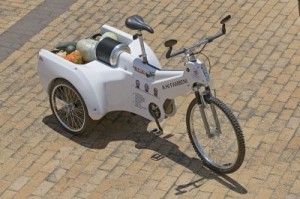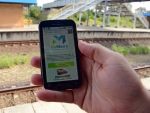
Locally designed hydrogen-powered tricycle – named ‘A hi Fambeni’, Xitsonga for ‘Let’s go’ – has attracted much attention since its 2010 launch in South Africa as a sustainably powered goods-to-market vehicle for rural areas.
It’s also an entry into the international SMART Mobility EnterPrize competition, which aims to identify existing and emerging sustainable mobility business models and innovative transport approaches that benefit the poor. Entries need to show that they are innovative, replicable, improve quality of life / sustainability for a community or communities, and improve access to basic needs.
A hi Fambeni’s technology was developed by the students of the Tshwane University of Technology’s Resource Driven Technology Concept Centre (RETECZA), and the body designed by South African motorcycle designer Pierre Terblanche, who was design director for Ducati from 1997 to 2007.
The hydrogen tricycle project begun as a demonstration project for Hydrogen SA (HySA), to show what hydrogen could do for the country, says Bob Bond, project leader and board member of RETECZA. ‘We had eight months in which to develop a demonstration hydrogen vehicle, so a bicycle/tricycle was the obvious choice.’
‘It would have been great to do a bus, but we didn’t have the time. So we started small and chose to look at mobility requirements in rural areas.’
‘In Phase two, we’d like to look at how we can produce the power source using wind or solar. You could even plug your lights and your television into your bike, it could be a portable power supply, not only a vehicle for mobility.’
RETECZA is an academia-industry-public partnership initiative aiming to alleviate poverty by facilitating clean energy, rural transport and clean water.
‘Within four weeks we had a cardboard model, which Terblanche – who was born in Graaff-Reinet – designed pro bono, but then came the difficult part, the “underskin” work,’ says Bond.
‘The Achilles heel of the hydrogen economy is how to safely store the hydrogen,’ he says. ‘One way is to cool it to a liquid. Another is to pressurize it to a gas. We’ve resolved the problem by developing a high-temperature fuel cell using metal hydride storage technology, done at low pressure. Metal hydride powders, which have the consistency of sea sand, absorb the hydrogen, so it is chemically safe.’
Another challenge with hydrogen fuel cells is the endothermic reaction when charging the battery: the byproduct is heat, which is lost in the process and needs to be replaced, explains Bond. So Bond and and his team designed a closed loop solution, where these byproducts are redirected back put to good use instead, and redirected to either heat or cool the tank. For example, when the battery is discharging – in other words when the bike is running – ‘you can see the water vapour, it’s lovely,’ says Bond. Like riding an air-conditioned tricycle.
The tricycle uses 100 g of hydrogen gas, has an operational speed of 25 km/h, and duration of 3 to 5 hours. The design is pedal assisted and the rider can select the amount of power input from the electrical drive motor. The 2,6l tank is housed at the rear of the bicycle. The high temperature fuel cell is located ahead of the load bay and shock mounted.
The idea isn’t necessarily to produce fuel-cell tricycles en-masse, but to use this model as a concept from which to develop self-sustaining solutions for rural mobility needs. ‘We’re not suggesting that everyone ride a vehicle like this one,’ says Bond, ‘but what we’re developed is scaleable technology. We’re are looking at vehicles powered by hydrogen, produced from renewable resources, totally off-grid – which could transport people to schools, hospitals, markets… We could even design electric-assist donkey carts.’
—-
New Mobility – also known as ‘sustainable transportation’ – is about moving people, moving goods, and moving less, in ways that are cleaner, greener, safer, healthier, and more equitable (and more ‘hip’, of course…).
The SMART Mobility EnterPrize was conceived and developed by the University of Michigan SMART initiative and its local and international partners, with the generous support of the Rockefeller Foundation. It is part of a SMART’s wider ‘Catalyzing the New Mobility in Cities’ project.
So if you are an entrepreneur with a venture that advances New Mobility, visit http://www.mobiprize.com and apply online. The deadline is 1 April 2012.




Leave a comment